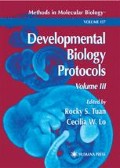Abstract
In vitro techniques for the study of chondrogenic differentiation of embryonic limb mesenchymal cells have been available for some time. Early methods require highdensity confluent monolayer cell cultures (1,2). The micromass culture method developed by Ahrens et al. (3) represented a convenient system for the observations and analysis of the differentiative processes and phenomena analogous to those exhibited by the limb cartilage anlagen in situ. In these cultures, limb mesenchymal cells first undergo condensation giving rise to aggregates that later become cartilage nodules (3,4), thereby mimicking the differentiative phenomena occurring during embryonic limb development in vivo, i.e., mesenchymal condensation preceding cartilage differentiation (5–9). The micromass limb mesenchymal culture system has gained great popularity for the analysis of the regulatory steps and differentiative processes that result in the condensation of the mesenchyme and the formation and maturation of the cartilage anlagen.
Access this chapter
Tax calculation will be finalised at checkout
Purchases are for personal use only
References
Umansky, R. (1966) The effect of cell population density on the developmental fate of reaggregating mouse limb bud mesenchyme. Dev. Biol. 13, 31–56.
Caplan, A. (1970) Effects of the nicotinomide-sensitive teratogen 3-acetylpyridine on chick limb cells in culture. Exp. Cell Res. 62, 341–355.
Ahrens, P. B., Solursh, M., and Reiter, R. S. (1977) Stage-related capacity for limb chondrogenesis in cell culture. Dev. Biol. 60, 69–82.
Solursh, M., Ahrens, P., and Reiter, R. (1978) A tissue culture analysis of the steps in limb chondrogenesis. In Vitro 14, 41–61.
Kosher, R., Savage, M., and Chan, S. (1979) In vitro studies on the morphogenesis and differentiation of the mesoderm subjacent to the apical ectodermal ridge of the embryonic chick limb bud. J. Embryol. Exp. Morphol. 50, 75–97.
Newman, S., Pautou, M. P., and Kierney, M. (1981) The distal boundary of morphogenic primordia in chimeric avian limb buds and its relation to an accessible population of cartilage progenitor cells. Dev. Biol. 84, 440–448.
San Antonio, J. D. and Tuan, R. S. (1986) Chondrogenesis of limb bud mesenchyme in vitro: stimulation by cations. Dev. Biol. 115, 313–324.
Jiang, H., Soprano, D. R., Li, S. W., Soprano, K. J., Penner, J. D., Gyda, M., III, and Kochhar, D. M. (1995) Modulation of limb bud chondrogenesis by retinoic acid and retinoic acid receptors. Int. J. Dev. Biol. 39(4), 617–627.
Thorogood, P. V. and Hinchcliffe, J. R. (1975) An analysis of the condensation process during chondrogenesis in the embryonic chick hind limb. J. Embryol. Exp. Morphol. 33, 581–606.
Tuan, R. S., Scott, W. A., and Cohn, Z. A. (1978) Calcium-binding protein of the chick chorioallantoic membrane. II. Vitamin K-dependent expression. J. Cell Biol. 77, 752–761.
Boskey, A. L., Stiner, D., Doty, S. B., Binderman, I., and Leboy, P. (1991) Studies of mineralization in tissue culture: optimal conditions for cartilage calcification. J. Bone Min. Res. 16, 11–36.
Aulthouse, A. A. and Solursh, M. (1987) The detection of a precartilage, blastema specific marker. Dev. Biol. 84, 440–448.
Milaire, J. (1991) Lectin binding sites in developing mouse limb buds. Anat. Embryol. 184, 479–488.
Zimmermann, B. and Thies, M. (1984) Alterations of lectin binding during chondrogenesis of mouse limb bud. Histochemistry 81, 353–361.
Stringa, E. and Tuan, R. S. (1996) Chondrogenic cell subpopulation of chick embryonic calvarium: isolation by peanut agglutinin affinity chromatography and in vitro characterization. Anat. Embryol. 223, 1–11.
Stringa, E., Love, J. M., McBride, S. C., Suyama, E., and Tuan, R. S. (1997) In vitro characterization of chondrogenic cells isolated from chick embryonic muscle using peanut agglutinin affinity chromatography. Exp. Cell Res. 232(2), 287–294.
Kiernan, J. A. (1990) Histological and Histochemical Methods: Theory and Practice, 2nd ed. Pergamon Press, New York.
Jacenko, O. and Tuan, R. S. (1986) Calcium deficiency induces expression of cartilagelike phenotype in chicken embryo calvaria. Dev. Biol. 115, 215–232.
Gavrieli, Y., Sherman, Y., and Ben-Sasson, S. A., (1992) Identification of programmed cell death in situ via specific labeling of nuclear DNA fragmentation. J. Cell. Biol. 119(3), 493–501.
Ray, S., Ponnathpur, V., Huang, Y., Tang, C., Mahoney, M. E., Ibrado, A. M., et al. (1994) 1-β-D-Arabinofuranosylcytosine-, mitoxantrone-, and paclitaxel-induced apoptosis in HL-60 cells: improved method for detection of internucleosomal DNA fragmentation. Cancer Chemother. Pharmacol. 34, 365–371.
Tilly, J. and Hsueh, A. J. W. (1993) Microscale autoradiographic method for the qualitative and quantitative analysis of apoptotic DNA fragmentation. J. Cell Phys. 154, 519–526.
Hamburger, V. and Hamilton, H. L. (1951) A series of normal stages in the development of the chick embryo. J. Morphol. 88, 49–92.
Lev, R. and Spicer, S. S. (1964) Specific staining of sulfate groups with Alcian blue at low pH. J. Histochem. 12, 309.
Mello, M. A. and Tuan, R. S. (1999) High density micromass cultures of embryonic limb bud mesenchymal cells: an in vitro model of endochondral skeletal development. In Vitro Cell Dev. Biol. 35, 262–269.
Mello, M. A. and Tuan, R. S. (1998) Cartilage maturation in vitro is influenced by TGF-β1 and T3. Trans. Ortho. Res. Soc. 44, 495.
Reginato, A. M., Tuan, R. S., Ono, T., Jimenez, S. A., and Jacenko, O. (1993) Effects of calcium deficiency on chondrocyte hypertrophy and type X collagen expression in chick embryonic sternum. Dev. Dyn. 189, 284–295.
Arends, M. J., Morris, R. G., and Wyllie, A. H. (1990) Apoptosis: the role of the endonuclease. Am. J. Pathol. 136, 593–608.
Author information
Authors and Affiliations
Editor information
Editors and Affiliations
Rights and permissions
Copyright information
© 2000 Humana Press Inc., Totowa, NJ
About this protocol
Cite this protocol
De Lise, A.M., Stringa, E., Woodward, W.A., Mello, M.A., Tuan, R.S. (2000). Embryonic Limb Mesenchyme Micromass Culture as an In Vitro Model for Chondrogenesis and Cartilage Maturation. In: Tuan, R.S., Lo, C.W. (eds) Developmental Biology Protocols. Methods in Molecular Biology™, vol 137. Humana Press. https://doi.org/10.1385/1-59259-066-7:359
Download citation
DOI: https://doi.org/10.1385/1-59259-066-7:359
Publisher Name: Humana Press
Print ISBN: 978-0-89603-854-7
Online ISBN: 978-1-59259-066-7
eBook Packages: Springer Protocols

